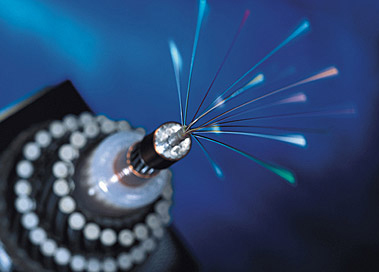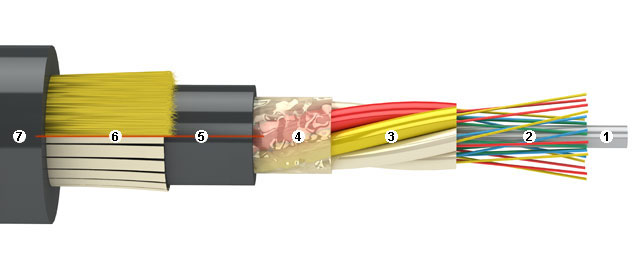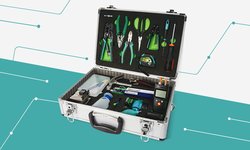Optical Fiber Fusion Splicing: Optical Cables Classification
We would like to offer a series of articles on installing and maintaining fiber optic networks for your attention. The first article in a series is devoted to the types of fiber optic cables.
What is a fiber optic cable? In this article, we will discuss the cable types and its components.

Fiber Optic Cable Types
Cables can be broken up in categories / types based on design, points of use and installation conditions.
Design. Cables can vary from the simplest cables – composed of a clad layer with plastic tube-modules underneath and fibers inside, to super-sophisticated – composed of many layers and having two-level armoring like in underwater transoceanic cables.

Points of Use. There are cables for installing outdoor and indoor (indoor laying is rare and is mostly used in premium data centers where everything should be flawless and fancy).
Installation Conditions. Cables can be used for suspension (with a Kevlar or rope), for laying in the ground (with armor made of iron wires), for laying in cable conduits (with corrugated metal armor), for underwater installation (complex super-protected multilayer structure), for suspension on power transmission line towers (apart from transferring data, they are used as ground wearers). Cables for suspending on poles (with Kevlar) and for laying in the ground (with armor) are used most often, while cables with a rope and with a corrugated metal armor come seldom. Another type of a cable often used is essentially a thin paired optical patch cord (with a yellow coating for a single-mode cable and an orange coating for a multimode cable, with some Kevlar and one fiber; two coatings are paired). Other optical cables (unprotected, underwater, and for laying indoor) are very rarely used (exotic).
Fiber Optic Cable Components

1. Cable central member (in other words, a rod made of fiberglass, although it may be a rope in a PE jacket)
Serves for centering tube-modules and stiffening the entire cable. Behind it, a cable is fixed in the coupling / cross, clamping it under the screw. When being strongly bent, a cable tends to unexpectedly break, breaking modules with some fibers along the way. In more advanced cable designs, this rod is clad in a PE sheath: it is then more difficult to break it and the cable will be less damaged after the cut.
2. Optical fibers (in the picture - with varnish insulation)
These are superfine filaments or fibers. They are the reason for installing a cable in the first place. The article will only discuss glass fibers, although there also exist plastic fibers, but they are very exotic; they cannot be spliced by fusion splicers (only by mechanical connection) and can be used only at very short distances. Optical fibers can be single-mode and multi-mode; multimode fibers are a less common technology; it can only be used for short distances and in many cases is perfectly replaced by a single-mode technology.
A fiber consists of a glass cladding made of glass with certain additions. Without varnish, a fiber is 125 microns thick (a little thicker than a single hair), and in the center comes a core of 9 microns in diameter from ultra-pure glass with a different composition and with a refraction index slightly different from that in the cladding. It is in the core that there is propagation of light (due to the effect of total reflection on the core-to-cladding interface).
Finally, the 125-micrometer cylinder of cladding is covered with another cladding on top - from a special varnish (transparent or colored - for fiber color marking), which is also two-layered. It protects the fiber from moderate damage (without varnish, the fiber can be bent, but not very well and it is easy to break; the fiber may crumble even when a mobile phone is accidentally placed on it, and while varnish insulated it can be safely wrapped around a pencil and pulled pretty hard – and it will withstand).
It happens that cable span sags down on fibers only: all claddings and Kevlar cable are ripped, burnt or cut, the central member has failed , and then these 16 or 32 125-micrometer glass fibers can hold up the cable span and wind loads for weeks! Nevertheless, even when varnish insulated, fibers can be easily damaged, so the most important thing in a splicer’s work is being meticulous and accurate. With one awkward movement, you can spoil the results of the whole day of work or, if you are not particularly lucky and there is no reservation, permanently drop the backbone link (if the fiber using DWDM is totally broken at the exit point of the cable, when you dig into operational main clutch).
There are many varieties of fiber: single mode fiber (SMF or just SM), dispersion shifted fiber (DSF or simply DS), non-zero dispersion shifted fiber (NZDSF, NZDS or NZ). You cannot distinguish them outwardly; difference lies in chemical / crystalline composition and, possibly, in the central bar geometry and in the smoothness of a core-cladding boundary. Dispersion in optical fibers is difficult to understand; it is a piece worthy of a separate article; therefore, if we put it easier, distorted dispersion shifted fibers can transmit an undistorted signal to a greater distance than single-mode ones. In practice, splicer operators know two types of signal: single-mode and shifted. In a cable, the first module is often selected for dispersion shifted fibers, and the rest - for single-mode fibers. You can join dispersion shifted and single mode fibers, but it is undesirable because it causes an interesting effect we’ll discuss in an article on measurements.
3. Plastic tube-modules (where fibers float in hydrophobic gel)

They break easily (or more precisely, suddenly bend), bending like telescopic antennas in household receivers and breaking the fibers inside. Sometimes there is only one module (a thick tube), and there is a bundle of fibers in it, but then you need too many different colors for color-coding, so several modules are used, each of which has 4 to 12 fibers. There is no single standard for color-coding and the number of modules / fibers; each manufacturer does in its own way, reflecting it in the passport for the cable. The passport is attached to the laying-out reel and is usually pinned by a stapler to the wood surface right inside the reel.
Cables from the same manufacturer may have the same configuration. However, you still need to look at the cable passport, where the detailed coloring and types of fibers in different modules are indicated. The minimum capacity of cables often used is 8 fibers, and the maximum – 96 fibers. Usually it is 32, 48, or 64 fibers. Only one or two modules may be used out of the whole cable length; in this case black dummy plugs are inserted instead of remaining modules (so that the overall dimensions of the cable do not change).
We have a full range of tools and equipment for Fiber Optic Patch Cord Production.
4. Film (module sheathing film)
Its role is not critical - damping, reducing friction inside the cable, additional protection from moisture, keeping hydrophobic gel between modules and maybe more. Additionally, the film is often tied with threads crosswise and moistened on both sides with hydrophobic gel.
5. Thin inner polyethylene cladder
Additional protection against moisture, protective layer between Kevlar / armor and modules. Is not obligatory and may be absent.
6. Kevlar fibers or armor
In the figure, you see that armor is made of rectangular rods, but it is much more commonly made of round wires (steel wires are usually stiffened, so they are difficult to cut even with cable shears). Armor can also be fiberglass rods, like in the central member, but in fact, it is extremely rare. Kevlar is needed for the cable to withstand a high breaking force and not to be heavy at the same time. It is also often used instead of a rope when no metal should be present in the cable to avoid interference (for example, if the cable hangs along the railway with a contact wire of 27.5 kV). Typical values of the permissible tensile force for a cable with Kevlar are 6–9 kN; this allows a large span to withstand at wind load. When cutting Kevlar the cutting tools are blunting and becoming dull :) Therefore, it is better to use special scissors with ceramic blades or cut it off with cable shears.
As for the armor, it is designed to protect underground cables lying directly in the ground, without the protection of a plastic pipe, cable conduits, etc. However, the armor can only protect when a shovel is used; an excavator will still rip any type of cables. To avoid it, the underground cable is laid in the ground at the depth of 1m 20 cm; above the cable, a yellow or orange signal tape is placed with the print "Caution! Do not dig! Cable below" at a depth of 60 cm; moreover, bars, warning signs and notice plates are placed along the road. Still people dig and rip cables all the time.
7. Outer thick polyethylene clad layer
This cladding is the first to bear the weight of all hardships during the cable installation and operation. Polyethylene is soft, so it is easy to cut it inadvertently when tightening the cable. When laying the underground cable, a contractor may rip this cladding up to the armor for a few meters without noticing. The cable may then become wet when it is in the ground even though hydrophobic gel is used. Later, when testing the outer cladding with a megohmmeter at the time of delivery, the megohmmeter will display low resistance (high electrical leak).

If a hanging cable touches a concrete pole or tree, polyethylene can get quickly frayed up to fibers. There may be a PE film and some hydrophobic gel between the outer clad laying and the armor.
You can buy cables from such companies as Corning, OFS, Sumitomo, Fujikura, etc. All cables are believed to be similar in design / materials and they do not differ much in quality.

